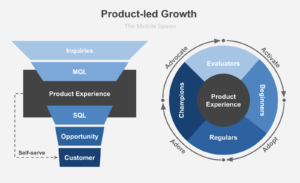Benefits and Drawbacks of Product-Led Growth in SaaS Most companies these days are looking for ways to grow their business. And while there are several different options to choose from, one of the most popular is product-led growth. But what exactly is product-led growth, and more importantly, is it right for your company? In this blog post, we’ll take a closer look at both the pros and cons of using product-led growth to drive your SaaS company forward.
source: announcekit.app
Table of Contents
What is product-led growth and how does it work in SaaS companies?
Product-led growth is a go-to-market strategy whereby the product itself is used as the primary driver of growth. In other words, rather than relying on things like marketing and sales to generate new customers, product-led growth relies on the product itself to do the heavy lifting.
There are some different ways that this can be achieved. For example, many companies will offer a free trial of their product to entice new users. Once they’re hooked, they’ll then start to pay for the product. Others will take a freemium approach, whereby the core product is offered for free but users have to pay for premium features.
For product-led growth to be successful, the product must be compelling enough to drive growth. After all, if users don’t find the product valuable, they’re not going to stick around (or pay for it).
The benefits of product-led growth
There are many advantages to using product-led growth in your SaaS company. Perhaps the most obvious is that it’s a very cost-effective way to acquire new customers.
If you’re not spending money on marketing or sales, you’re automatically going to save a lot of money. And even if you are still investing in marketing and sales, you’ll likely need to spend less than you would if you were relying on them as your primary growth drivers.
Another key benefit of product-led growth is that it’s a great way to build a strong relationship with your customers from the very beginning.
When customers sign up for a free trial or use your product for the first time, they’re already starting to form an opinion of your company. If they have a positive experience, they’re more likely to continue using your product and eventually become paying customers. But even if they don’t become paying customers, they may still tell their friends and colleagues about your product – which could lead to more sign-ups down the line. Beamy lands $9M to help companies come through and manage their SaaS apps
The drawbacks of product-led growth
Of course, product-led growth is not without its drawbacks. The most obvious is that it can be very difficult to achieve.
As we mentioned before, for product-led growth to work, the product needs to be compelling enough to drive growth. And while there are some ways to make a product more appealing, there’s no guarantee that it will be successful.
Another potential drawback is that product-led growth can take a long time to achieve results. If you’re not seeing the kind of growth you want straight away, it can be easy to get discouraged and give up on the whole idea altogether.
Moreover, SaaS designers and developers need to keep in mind that a product that is great for driving growth may not be the most user-friendly or intuitive. In other words, there’s a balance to be struck between making the product appealing to users and making it easy to use. Visit blog by Eleken to read more about this topic.
Finally, it’s worth noting that product-led growth is not a magic bullet – it’s just one tool in your arsenal. Even if you do manage to achieve impressive growth using this strategy, there’s no guarantee that it will be sustainable in the long term.
When to use product-led growth and when to switch to another growth model
Product-led growth can be a great way to kickstart your SaaS company’s growth. However, it’s not the right strategy for every company.
If you’re not sure whether product-led growth is right for you, ask yourself the following questions:
– Does my product have the potential to drive growth on its own?
– Am I prepared to invest the time and resources needed to make my product more appealing to users?
– Do I have the patience to wait for results?
– Am I willing to sacrifice user-friendliness for the sake of growth?
If you answered yes to all of the above, then product-led growth could be a good option for you. However, if you’re not confident that your product can drive growth or you’re not willing to invest the time and resources needed, then it might be better to switch to another growth model.
In the end, the decision of whether or not to use product-led growth should come down to what you think is best for your company.
How to implement product-led growth in your company
After answering the questions above, if you decided that product-led growth is the right strategy for your company, there are a few key steps you need to take to implement it.
First, you need to make sure that your product is appealing to users. This means continuing to invest in making your product more user-friendly and intuitive. It also means ensuring that your product solves a real problem that users are willing to pay for.
Second, you need to focus on acquisition and making it easy for new users to sign up for your product. This means investing in marketing and advertising to reach new audiences. It also means making sure that your pricing is attractive and that the sign-up process is as straightforward as possible.
Third, you need to ensure that your users have a positive experience with your product. This means paying close attention to user feedback and making sure that any problems are quickly addressed. It also means continuing to invest in making your product more user-friendly and intuitive.
Finally, you need to be prepared to scale. This means having the infrastructure in place to support a larger number of users. It also means continuing to invest in marketing and advertising to reach new audiences.
Product-led growth can be a great way to kickstart your SaaS company’s growth. However, it’s not the right strategy for every business.
Examples of successful product-led growth strategy
Several companies have achieved success using product-led growth.
A great example is Slack, which is a communication tool for businesses. Slack’s success is largely due to its focus on making the user experience as simple and intuitive as possible. The company also offers a free version of its product, which makes it easy for new users to sign up and start using the product.
Another example is Dropbox, which is a file-sharing service. Dropbox achieved success by making it easy for new users to sign up and use the product. The company also offers a free version of its product, which makes it easy for new users to try the product and see the value it offers.
Final thoughts
If you do decide to go ahead with product-led growth, make sure to invest in making your product more user-friendly and intuitive. Focus on the acquisition and make it easy for new users to sign up. Pay attention to user feedback and be prepared to scale.










